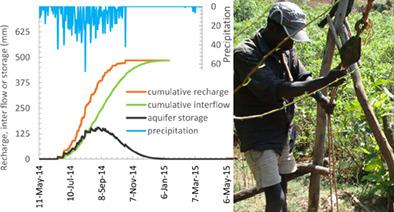当前位置:
X-MOL 学术
›
Hydrol. Process.
›
论文详情
Our official English website, www.x-mol.net, welcomes your
feedback! (Note: you will need to create a separate account there.)
Establishing irrigation potential of a hillside aquifer in the African highlands
Hydrological Processes ( IF 2.8 ) Pub Date : 2020-02-08 , DOI: 10.1002/hyp.13659 Seifu A. Tilahun 1 , Debebe L. Yilak 1 , Petra Schmitter 2 , Fasikaw A. Zimale 1 , Simon Langan 3 , Jennie Barron 3, 4 , Jean‐Yves Parlange 5 , Tammo S. Steenhuis 1, 5
Hydrological Processes ( IF 2.8 ) Pub Date : 2020-02-08 , DOI: 10.1002/hyp.13659 Seifu A. Tilahun 1 , Debebe L. Yilak 1 , Petra Schmitter 2 , Fasikaw A. Zimale 1 , Simon Langan 3 , Jennie Barron 3, 4 , Jean‐Yves Parlange 5 , Tammo S. Steenhuis 1, 5
Affiliation

|
Feeding 9 billion people in 2050 will require sustainable development of all water resources, both surface and subsurface. Yet, little is known about the irrigation potential of hillside shallow aquifers in many highland settings in sub‐Saharan Africa that are being considered for providing irrigation water during the dry monsoon phase for smallholder farmers. Information on the shallow groundwater being available in space and time on sloping lands might aid in increasing food production in the dry monsoon phase. Therefore, the research objective of this work is to estimate potential groundwater storage as a potential source of irrigation water for hillside aquifers where lateral subsurface flow is dominant. The research was carried out in the Robit Bata experimental watershed in the Lake Tana basin which is typical of many undulating watersheds in the Ethiopian highlands. Farmers have excavated more than 300 hand dug wells for irrigation. We used 42 of these wells to monitor water table fluctuation from April 16, 2014 to December 2015. Precipitation and runoff data were recorded for the same period. The temporal groundwater storage was estimated using two methods: one based on the water balance with rainfall as input and baseflow and evaporative losses leaving the watershed as outputs; the second based on the observed rise and fall of water levels in wells. We found that maximum groundwater storage was at the end of the rain phase in September after which it decreased linearly until the middle of December due to short groundwater retention times. In the remaining part of the dry season period, only wells located close to faults contained water. Thus, without additional water sources, sloping lands can only be used for significant irrigation inputs during the first 3 months out of the 8 months long dry season.
中文翻译:

确定非洲高地山坡含水层的灌溉潜力
到 2050 年养活 90 亿人将需要所有水资源的可持续发展,包括地表和地下。然而,人们对撒哈拉以南非洲许多高地地区山坡浅层含水层的灌溉潜力知之甚少,这些地区正被考虑在干旱季风阶段为小农提供灌溉用水。关于斜坡土地上在空间和时间上可用的浅层地下水的信息可能有助于在干燥季风阶段增加粮食产量。因此,这项工作的研究目标是估计潜在的地下水储存量,作为潜在的灌溉水源,用于侧向地下流占主导地位的山坡含水层。该研究是在塔纳湖盆地的罗比特巴塔实验流域进行的,该流域是埃塞俄比亚高地许多起伏流域的典型代表。农民们挖了300多口手挖井进行灌溉。我们使用其中的 42 口井监测了 2014 年 4 月 16 日至 2015 年 12 月的地下水位波动。记录了同期的降水和径流数据。使用两种方法估算临时地下水储量:一种基于以降雨为输入、基流和离开流域的蒸发损失作为输出的水平衡;第二个基于观察到的井中水位的上升和下降。我们发现最大的地下水储存量出现在 9 月的雨期结束时,此后由于地下水滞留时间短,它线性下降,直到 12 月中旬。在旱季的剩余时间里,只有靠近断层的水井才有水。因此,在没有额外水源的情况下,坡地只能在 8 个月长旱季的前 3 个月内用于大量灌溉投入。
更新日期:2020-02-08
中文翻译:

确定非洲高地山坡含水层的灌溉潜力
到 2050 年养活 90 亿人将需要所有水资源的可持续发展,包括地表和地下。然而,人们对撒哈拉以南非洲许多高地地区山坡浅层含水层的灌溉潜力知之甚少,这些地区正被考虑在干旱季风阶段为小农提供灌溉用水。关于斜坡土地上在空间和时间上可用的浅层地下水的信息可能有助于在干燥季风阶段增加粮食产量。因此,这项工作的研究目标是估计潜在的地下水储存量,作为潜在的灌溉水源,用于侧向地下流占主导地位的山坡含水层。该研究是在塔纳湖盆地的罗比特巴塔实验流域进行的,该流域是埃塞俄比亚高地许多起伏流域的典型代表。农民们挖了300多口手挖井进行灌溉。我们使用其中的 42 口井监测了 2014 年 4 月 16 日至 2015 年 12 月的地下水位波动。记录了同期的降水和径流数据。使用两种方法估算临时地下水储量:一种基于以降雨为输入、基流和离开流域的蒸发损失作为输出的水平衡;第二个基于观察到的井中水位的上升和下降。我们发现最大的地下水储存量出现在 9 月的雨期结束时,此后由于地下水滞留时间短,它线性下降,直到 12 月中旬。在旱季的剩余时间里,只有靠近断层的水井才有水。因此,在没有额外水源的情况下,坡地只能在 8 个月长旱季的前 3 个月内用于大量灌溉投入。











































 京公网安备 11010802027423号
京公网安备 11010802027423号